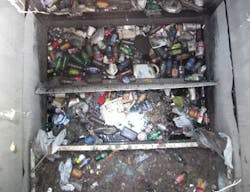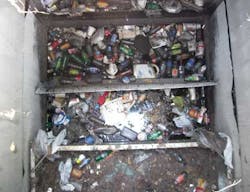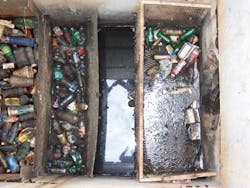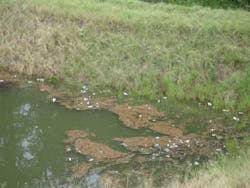Best Management Practices (BMPs): The Maintenance Element
Part 3 of a three-part series on stormwater Best Management Practices
Read part 1 > Best Management Practices (BMPs): The Design Element
Read part 2 > Best Management Practices (BMPs): The Installation Element
The first two installments of this series dealt with the proper design and installation of stormwater BMPs. While there are plenty of poorly designed BMPs in operation, and just as many well-designed BMPs that were installed properly, our field crews find that the major shortcoming of all our water quality efforts can be attributed to the lack of proper maintenance. No matter how carefully the design professional works to make an approvable and effective BMP, or how meticulously the contractor works to get the installation exactly right, there is one further step needed to assure that the promise of improved water quality is realized. That final step is a good inspection, maintenance and cleaning program that's tailored to that specific BMP. The lack of post-construction attention to this aspect of water quality is a black eye for an otherwise effective process.
Generally, the term "maintenance" is used to encompass the entire process of inspection, routine maintenance and cleaning, and that is how it will be used here.
Today, the term BMP is widely inclusive of procedures, practices and structural elements that are designed to mitigate changes in water quantity and water quality that come with land development. While most of us focus on controlling pollution when a land use is changed, this can only impact a small portion of the problem that exists from over 200 years of land use change that preceded the adoption of the Clean Water Act in 1972.
To correct those impacts, a retrofit program will ultimately be implemented (albeit slowly) that also will rely on BMPs. This will mean a change in the way we think about controlling pollution. We will move from "percentage of removal" to numeric effluent limits, and from "match pre-development conditions" to improving watershed impacts. No matter how we define the term BMP or what rules we put in place to protect watersheds, the basic function of a BMP is to trap and hold pollutants by some method and to prevent those materials from proceeding downstream to our waterbodies.
We can settle, screen, filter, infiltrate, precipitate, adsorb, absorb, flocculate, foster chemical changes and use many other techniques to accomplish the goal of pollutant removal but settling vessels will fill, filters and screens will clog, chemicals will become exhausted. In short, every BMP will need to be cleaned, renewed, replaced or removed at some point. All of these activities -- and the inspections needed to determine the condition of a BMP -- fall under the broad heading of "Maintenance." If we do not plan on this happening, we are ignoring the obvious.
I like to use construction BMPs as examples of the need for maintenance because the birth, lifetime and demise of a construction BMP is short. Post-construction BMPs are no different but the loading rate for pollutants and the timing of maintenance activities is typically longer. In the first two installments of this series, we talked about proper design and installation of BMPs, so this example will include those two attributes.
Assuming that 1) a jurisdiction has good regulations that require silt fencing to control sediment wash off; 2) a good engineer produced plans that properly placed the silt fence, and 3) a good contractor followed the plans exactly, this common BMP probably did its job very well during construction. A part of the maintenance for this properly designed and installed BMP involved inspecting the silt fence after large events and perhaps making repairs to be sure that it continued to work well and did not have any problems.
Now, the job is over, and it is time to remove the silt fence. It has done its job and trapped sediments behind the fence to prevent them from going downstream. If the fence is simply pulled up the material collected behind it will wash away downstream. Thus, the material collected and held by the silt fence must be removed.
Further, taking down the fence and removing the sediment will leave some bare ground that must be seeded and mulched so that it will stabilize. This small job is not much different than the large job of dredging a wet pond to remove built up sediments.
When something complex -- like dredging a pond after several years in service -- is considered, it is important to understand what led up to the dredging. Over the years prior to dredging, there would have been periodic inspections and routine maintenance. The inspections would have found small problems and measured the capacity of the pond as it slowly filled with sediment. Examples of "small problems" would include any structural drainage damage to rip rap, outlet control structures, trees sprouting in the pond's dam, pest infestations or clogging of the "slow drawdown" drainage structure.
Routine maintenance would have included mowing in the summer, policing up trash and debris, removing invasive water plants or algae and measuring sediment depth. If all this has been done on a periodic basis, the need to dredge the pond will be predictable at some point, and preparations can be made for that process.
It is critical to do periodic inspections and maintenance because there is no possible way to accurately predict in advance what quantities and types of materials materials will wash off of a site. This unpredictability is true for any post-construction BMP. Despite the critical need for inspection, most BMPs -- like a pond -- are simply left alone to fill up, deteriorate and stop working over time. Despite the fact that the BMP was given credit for 80% removal of pollutants, exactly zero percent of anything is ever removed until there is a failure emergency.
No structure imposed into flowing water lasts forever, including that big "pond" behind Boulder Dam. Water is no respecter of removal assumptions or theoretical efficiency rates. This is a physical reality that one can check by visiting most of the material from the ancient Appalachian Mountains, which can be found on the Gulf Coast and Atlantic beaches of our continent. Sometimes slowly, but always surely, water entrains and transports material downstream to the oceans by way of our waterways. If the material is deleterious to our environment, it is naïve to assume that it is "taken up" by some means, unless we physically take it up and remove it. If we are not willing to interrupt the steady transport of material to the sea by maintaining our BMPs, we might as well lower the efficiency rates to zero and forget about improving water quality.
The challenge of the Clean Water Act is a large, complex problem but we should not forget that it is a physical effort. We are dealing with chaos at every turn in the weather, the site conditions on the surface, and the physics of flowing and standing water. To meet the challenge, we need an organized and consistent approach to the physical removal of materials from our BMPs. Wonderful new tools like continuous simulation models, new media, and innovative on-site reuse systems have given us the ability to improve water quality. But without continuous attention to maintenance, nothing else we do is meaningful.
Our maintenance company sees BMP failures every day. We do see occasional design failures and installation failures but, most of all, we see maintenance failures. Almost every conversation about water quality concerns BMP testing, design, proper approvals and new regulations to implement green infrastructure and low impact development. Perhaps the conversation ought to be about how all of this will fail if no one is willing to do the hard work that is needed to achieve real pollutant removal. It is not easy but it is the only way to keep what washes off of our sites out of our waterways and, eventually, out of the world's oceans.
Read part 1 > Best Management Practices (BMPs): The Design Element
Read part 2 > Best Management Practices (BMPs): The Installation Element
About the Author: John Moll is the CEO of CrystalStream Technologies, and is an active researcher in the water quality field. John holds eight water quality related patents, and has incorporated a maintenance company into CrystalStream that has provided invaluable data about actual field performance. The knowledge gained from over 6,000 maintenance operations has been integrated back into the design process and has helped guide new company initiatives.




